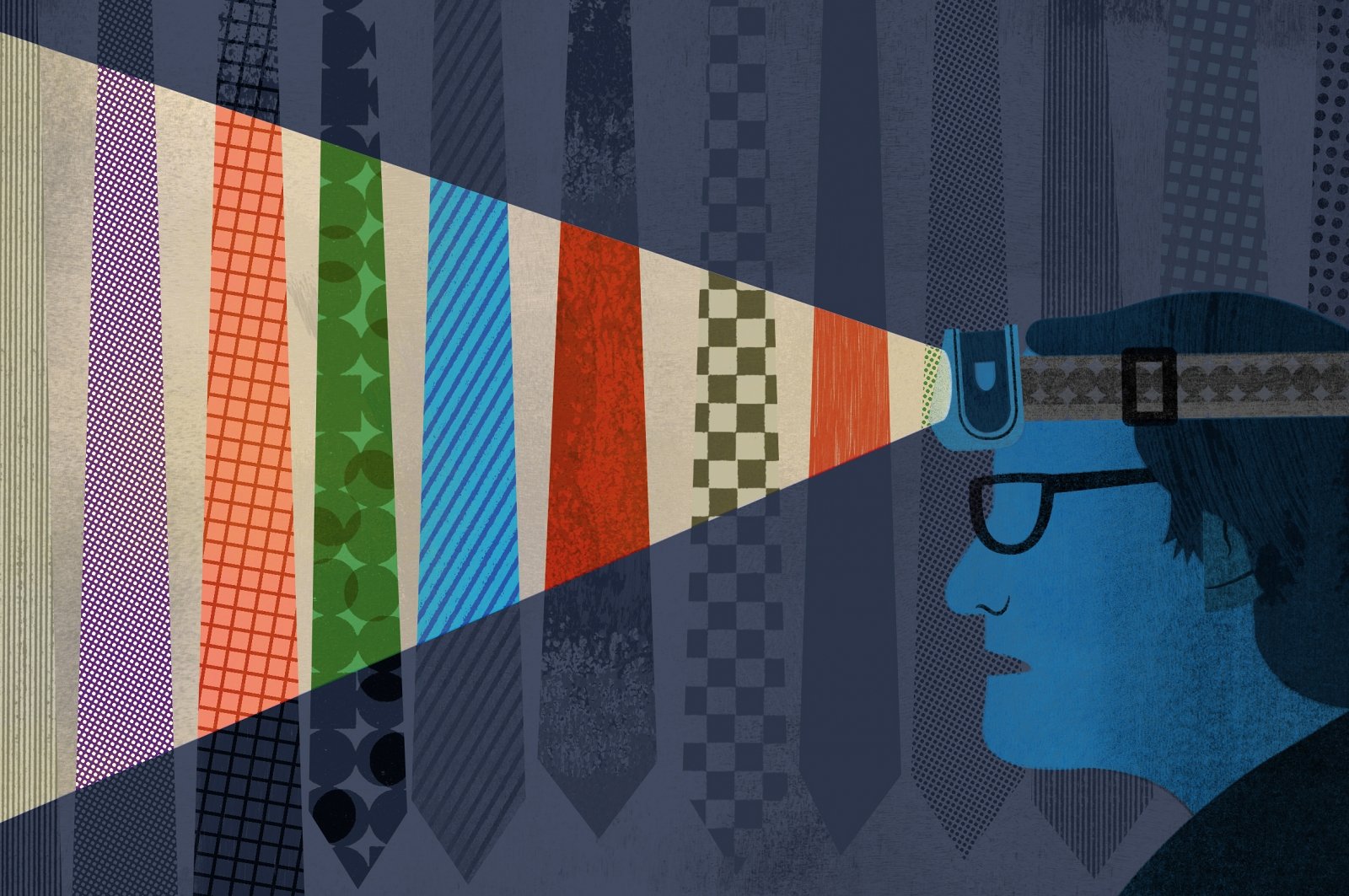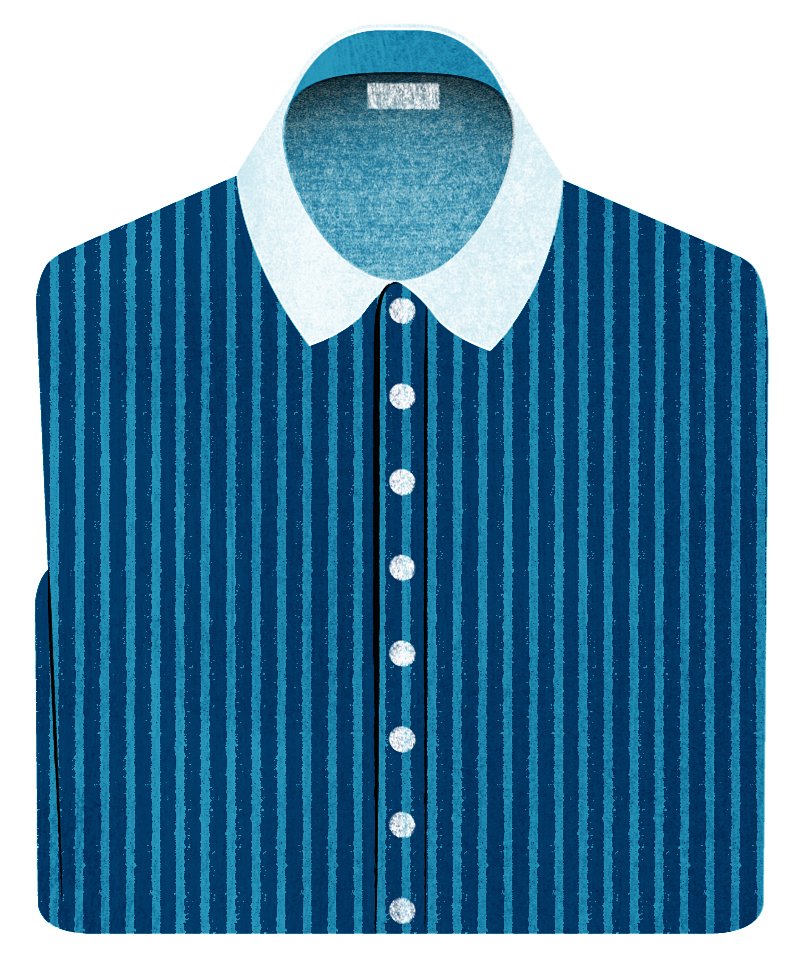
April 7, 2014
John Hockenberry Explores Design’s Unanticipated Consequences
Our new column by renowned
broadcast journalist and design
guru John Hockenberry

“My focus for this column is how design always has unanticipated consequences.”
Illustrations by Mitch Blunt
For the longest time, I have had this problem: I am capable of buying ballpoint ink pens only at art-supply stores. It’s where they look most at home. Not like in the impulse-buy checkout line where all the ballpoints seem to be desperate and willing to take any writing job whatsoever. This Calcutta of alms-seeking Bics and Parkers—next to the candy, diet aids, and glossy tabloid photos of Kanye, Justin, and Miley—begs for me to take one of them home to sign checks and bills, put Xs in boxes, or just scribble the occasional phone number. Thankfully, that’s something we haven’t needed to do much these days. Who scribbles down numbers anymore when mobile apps capture every bit of communications data we emit or absorb? In this regard, phones seem to have become mightier than the pen.
So for me, the pen can recapture its lost might by being displayed in a store along with shelves of exotic art supplies, where every object is associated with some creative task. The art-supply store in this conception becomes a room-size Swiss Army knife of creative possibilities—the pen grows mighty, just as the archaic little magnifying glass and toothpick on the largest Swiss Army knife gain stature by being in the same package as the scissors, saw, and blades. I wander the aisles of such stores and covet paint sets, brushes, knives, sketch pads, and blocks of clay. I breathe deeply all the toxic smells of paint and solvents and invent projects in my own mind that might justify filling a shopping cart with such fantasy tools. I have no artistic talent whatsoever but, in my mind, tool and action are nearly the same. Reality is something different. My cluttered home attests to a number of fantasy impulse buys that fell short of any real consistent “creative” action. I have a beautiful set of sushi knives that have not touched yellowtail flesh in more than a year and I am filled with horrible guilt over this. It is probably why I am scared to purchase anything but ballpoint pens at an art-supply store. Going beyond that would be dangerous. The pen is safe, but it is by no means the limit of my creative fantasies. So I buy my ballpoints at the art store, and that’s as far as it goes.
Is there room in a design magazine for someone whose chief motivation to make visual art is that it would provide him an excuse to go shopping in art-supply stores? It is this momentous question that I present for all you sincere and virtuous readers of Metropolis at the beginning of our journey together. I am something of a chimera in your midst part curious spectator, part practitioner. And art stores, as you may have gathered, are just the beginning.
I have always loved any kind of specialized tool and gadget for enthusiasts. Metal lathe? I’ve got to have one of those, or one of those massive Breitling watches with a half dozen dials that turn your wrist into a billboard for the present moment. Here is a watch that will be there for all of my adventures. Even if they can’t match my remains with dental records in the Formula One crash, that watch with a few scratches and smudges will still be working flawlessly (talk about going out on top). I also love the idea of wearing a device that tells you the precise air pressure and altitude at any moment. I am the kind of person who would take up skydiving just to wear that cool wrist altimeter. Put me in front of a glass case of scuba-diving gauges and sports meters and my mind races with reasons to own one—or five.


I am Walter Mitty in love with the Makita 18 volt LXT Lithium-Ion 15-piece power tool set. Why? If you have to ask, consider how empty your soul must be. I would write sonnets for the Industrial Grade 6500 power stand mixer from KitchenAid. It’s great for cakes and soufflés but, just in case, has plenty of power to turn bags of Quikrete into a lovely cat swimming pool in the front yard. But I come back to the guilt over the sushi knives, and there’s a whole other story about musical instruments that I won’t even get into. That said, today—in my late 50s—I am restrained, if not neutered, of this impulse. I do love to dream and, for me, that is where my notion of design resides.

Which brings me to the headlamp. I’ve always thought of myself as a person peering into the darkness of the world for much of my life as a journalist and storyteller—shining light to explain or reveal—but for the past seven years I have literally donned a headlamp each morning in the dark to prepare for the day. In 2007, I began doing a morning radio show that required me to get up at 2:00 a.m.
With a family of four kids (now five) and a sleep-deprived wife, there was no way to pull this off with the lights on. After a few days of mismatched socks and shirts buttoned in a way that did not inspire credibility while interviewing senators and Nobel Prize winners, I got myself a headlamp. It was a cumbersome, heavy, three-elastic-strap helmet looking thing with two or four AA batteries in a power module that gave it the heft of the slingshot David used to slay Goliath.
Even with the headlamp in this primitive incarnation, I can say that using it was by far the high point of my early morning shift. Curious children occasionally wondered if their father was related to the nocturnal mole creatures they were then learning about in science class, or my drowsy wife would see me as an apparition from the Watergate break-in, but I loved the freedom and ease of my “lumino-prosthetic.” It was especially helpful in my wheelchair, as it freed my hands and allowed me to move about while assembling daily combinations of clothes that actually matched, or keeping track of keys and wallets with ease.
It was more than simple functionality, and this is where the design piece comes in. I was suddenly and legitimately in the market for exotic “summit of Mount Everest” gear. I proudly went to REI to look at new designs of headlamps and watched their rapid evolution from cumbersome disposable-battery-charged cranial flashlights to my current favorite: the Petzl Tikka RXP 215 lumens boost power headlamp with a USB rechargeable battery that has a solar-power access-ory option. Okay, clearly this is overkill, but it is brilliant when a product designed for one application proves perfect for another. My focus for this column is how design always has unanticipated consequences.
The designers of the Petzl headlamp weren’t thinking about an aging father who uses a wheelchair being enabled in his morning routine when they imagined the programmable “wide-angle sharp beam” feature for reading maps on the face of a glacier at night. That same feature also happens to be perfect for lighting my way (wide beam) or picking out a decent tie (nar-row beam) while avoiding waking up a wife, two 15-year-olds, two 12-year-olds, and a toddler before their alarms go off. That is some super design, jumping two radically different applications in a single bound.
I hope to explore more of that in this space, with my curiosity on kill and my various impulse-buying instincts on stun. However this goes, nothing can shake me of the belief that good design is a beam of light into darkness. I live that every morning.





